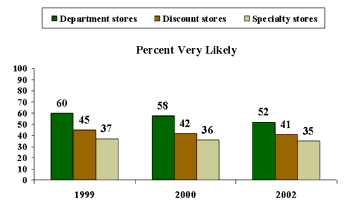GALLUP NEWS SERVICE
PRINCETON, NJ -- With just 22 shopping days left until Christmas, retailers are hoping for long lines at the cash registers. The weeks between Thanksgiving and Christmas can make or break a retailer's entire year, and Gallup Polls over the last 4 years show a declining trend in holiday spending by cash-conscious consumers. The latest numbers show the average American will spend $769 compared to $893 in 1999.
Where are those consumers most likely to spend their hard-earned money this holiday season? The latest CNN/USA Today/Gallup poll, conducted Nov. 22-24, 2002, shows that as of Nov. 24, only 9% of Americans had finished their holiday shopping. Nearly half, 48%, had yet to start. When Americans finally do get around to Christmas shopping, most will rely on their traditional favorites -- department and discount stores. Fifty-two percent of those surveyed indicate that they are "very likely" to do at least part of their shopping at department stores, while 41% are very likely to be looking for deals at discount stores.
However, those percentages have dropped for both categories over the last 3 years, along with the percentage of Americans who are likely to shop at specialty stores, such as hardware, jewelry, or electronics stores.
| How Likely Are You to Do Your Christmas Shopping at the Following? |
 |
Online Shopping Gains at Expense of Others
The only retail sector showing gains over the same period is online retailers, a sector in its infancy when Gallup first started asking about Internet holiday shopping in 1998. At that point, just 4% of Americans said they were very likely to do at least some online shopping for the holidays. In the most recent poll, 15% said they were very likely to do some of their shopping on the Internet.
This corresponds with a drop in the percentage of Americans who rely on mail-order catalogs for some or all of their holiday shopping. That percentage peaked in 1999 at 17%, but has since fallen to 13%. A caveat that must be mentioned: while some of the growth of Internet shopping can be attributed to online-only retailers such as Amazon.com, it is also likely that much of that traffic is going to online sites being run by "brick-and-mortar" retailers -- with shoppers choosing the convenience of ordering online instead of physically going to a retailer's store. Again, some of the apparent drop in catalog shopping may be linked to customers perusing a catalog at home and then ordering from the catalog retailer's Web site.
| How Likely Are You to Use the Following for Christmas Shopping? |
 |
Who's Shopping Where?
Putting aside the gender stereotypes about men and holiday shopping for a moment, our data show women are more likely than men to shop at department and discount stores, as well as online and by mail-order. Fifty-four percent of women are very likely to shop at department stores, compared with 49% of men. However, the difference is even greater when discount stores are taken into account: 48% of women will use that option, compared to 34% of men. Men are slightly more likely to shop at specialty stores (the jewelry factor), but the difference is not statistically significant.
Interestingly, those between the ages of 18 and 29 are the most likely to shop at department stores (59%, compared with 53% of those 30 to 49 and 47% of those 50 and older), but are not nearly as likely to use online shopping options as those in the 30 to 49 age bracket. Thirteen percent of those aged 18 to 29 are very likely to use online shopping, compared with 22% of those between the ages of 30 and 49. As might be expected, those 50 and older are the least likely to do their shopping online, with just 9% of Americans in that age group very likely to do so.
Online shopping is also most popular in the East and West, with slightly lower use in the Midwest and South. Those with higher incomes are also more likely to shop online, with 30% of those earning $75,000 or more annually very likely to do so.
More Socks and Shirts, Less Toys?
When asked to choose the type of gifts on which they will spend more of their holiday budget, 56% say "practical things that people really need" and 36% say "things that people don't necessarily need but might enjoy." Older Americans are far more likely to say they will be giving practical gifts than are younger Americans. Nearly two in three of those aged 65 and older will buy mainly practical gifts, compared to only half of those aged 18 to 29. Those in the youngest age category are nearly as likely to buy "fun" gifts (45%) as "practical gifts" (50%).
A similar pattern exists according to income, roughly 6 in 10 living in households in which the income is less than $50,000 will spend most of their holiday budget on practical gifts, while only about one in three in this income category will buy less practical gifts. Among those in the highest income category (those whose incomes are $75,000 or greater), 49% say they will mainly buy practical gifts and 45% will mainly buy gifts people might enjoy even if they don't need them.
Survey Methods
The results below are based on telephone interviews with a randomly selected national sample of 1,017 adults, aged 18 and older, conducted Nov. 22-24, 2002. For results based on this sample, one can say with 95% confidence that the maximum error attributable to sampling and other random effects is ±3 percentage points. In addition to sampling error, question wording and practical difficulties in conducting surveys can introduce error or bias into the findings of public opinion polls.
How likely are you to use the following to do your Christmas shopping -- very likely, somewhat likely, not too likely, or not at all likely? How about -- [RANDOM ORDER]?
A. Mail-order catalogues
|
Very |
Somewhat likely |
Not too likely |
Not at all likely |
No |
||
|
% |
% |
% |
% |
% |
||
|
2002 Nov 22-24 |
13 |
17 |
16 |
53 |
1 |
|
|
2000 Nov 13-15 |
12 |
22 |
20 |
46 |
* |
|
|
1999 Nov 18-21 ^ |
17 |
28 |
17 |
38 |
* |
|
|
1998 Dec 4-6 ^ |
14 |
21 |
15 |
50 |
* |
|
|
1993 Dec 4-6 ^ |
13 |
21 |
17 |
49 |
* |
|
|
^ |
WORDING: Catalogues |
|||||
B. Discount stores
|
Very |
Somewhat likely |
Not too likely |
Not at all likely |
No |
|
|
% |
% |
% |
% |
% |
|
|
2002 Nov 22-24 |
41 |
31 |
11 |
16 |
1 |
|
2000 Nov 13-15 |
42 |
33 |
12 |
13 |
* |
|
1999 Nov 18-21 |
45 |
34 |
11 |
10 |
* |
|
1998 Dec 4-6 |
48 |
32 |
9 |
11 |
* |
|
1993 Dec 4-6 |
51 |
31 |
9 |
8 |
1 |
C. Department stores
|
Very |
Somewhat likely |
Not too likely |
Not at all likely |
No |
|
|
% |
% |
% |
% |
% |
|
|
2002 Nov 22-24 |
52 |
32 |
7 |
8 |
1 |
|
2000 Nov 13-15 |
58 |
29 |
6 |
7 |
* |
|
1999 Nov 18-21 |
60 |
31 |
5 |
4 |
* |
|
1998 Dec 4-6 |
60 |
27 |
6 |
6 |
1 |
|
1993 Dec 4-6 |
51 |
33 |
7 |
8 |
1 |
D. Specialty stores, such as stores that sell only toys, or clothes, or jewelry, for example
|
Very |
Somewhat likely |
Not too likely |
Not at all likely |
No |
|
|
% |
% |
% |
% |
% |
|
|
2002 Nov 22-24 |
35 |
26 |
14 |
24 |
1 |
|
2000 Nov 13-15 |
36 |
28 |
16 |
19 |
1 |
|
1999 Nov 18-21 |
37 |
33 |
11 |
19 |
* |
|
1998 Dec 4-6 |
37 |
28 |
14 |
20 |
1 |
|
1993 Dec 4-6 |
24 |
29 |
21 |
25 |
1 |
E. On-line shopping on the Internet
|
Very |
Somewhat likely |
Not too likely |
Not at all likely |
No |
|
|
% |
% |
% |
% |
% |
|
|
2002 Nov 22-24 |
15 |
14 |
12 |
58 |
1 |
|
2000 Nov 13-15 |
9 |
12 |
14 |
65 |
* |
|
1999 Nov 18-21 |
8 |
11 |
14 |
67 |
* |
|
1998 Dec 4-6 |
4 |
6 |
7 |
82 |
1 |
SUMMARY TABLE: CHRISTMAS SHOPPING HABITS
|
2002 Nov 22-24 |
Very |
|
Very/ |
|
% |
% |
% |
|
|
Department stores |
52 |
32 |
84 |
|
Discount stores |
41 |
31 |
72 |
|
Specialty stores |
35 |
26 |
61 |
|
On-line shopping on the Internet |
15 |
14 |
29 |
|
Mail-order catalogues |
13 |
17 |
30 |

